Report on Organizational Behaviour: Culture, Motivation at Tesco
VerifiedAdded on 2023/01/03
|12
|3354
|22
Report
AI Summary
This report provides an analysis of organizational behaviour within Tesco, a large UK retailer, emphasizing the importance of organizational culture and its impact on employee motivation and overall organizational enhancement. It details various types of organizational cultures, including clan, adhocracy, market, and hierarchy cultures, and how these manifest within Tesco. The report explores how Tesco utilizes Maslow's hierarchy of needs to motivate employees through physiological, safety, and social means, as well as intrinsic and extrinsic motivation strategies. Furthermore, it examines the role of culture in fostering open communication, commitment, and innovation, ultimately contributing to Tesco's success as a leading retailer. The report concludes that a strong organizational culture is crucial for maintaining employee unity, providing a sense of identity, and facilitating continuous improvement within the company.
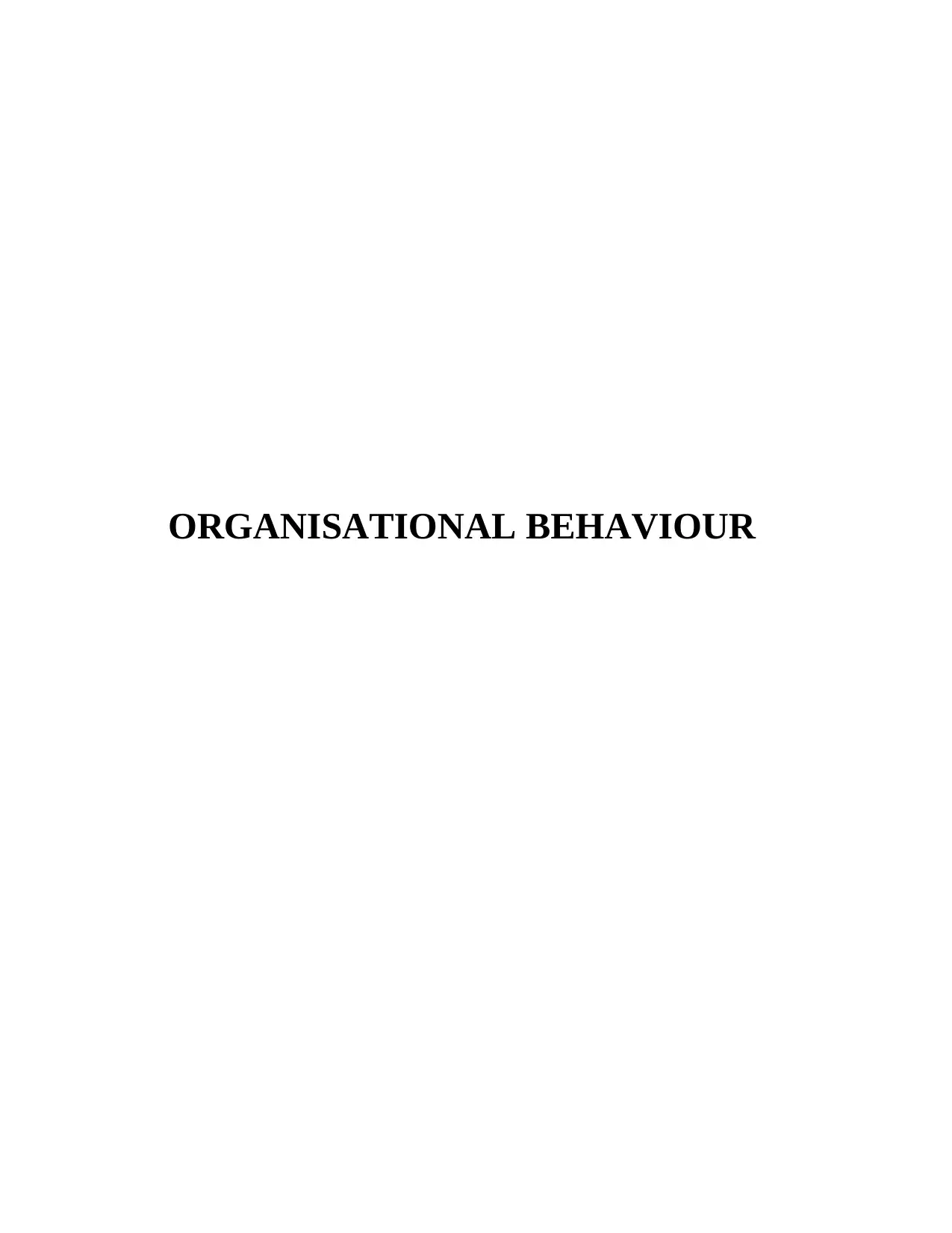
ORGANISATIONAL BEHAVIOUR
Paraphrase This Document
Need a fresh take? Get an instant paraphrase of this document with our AI Paraphraser
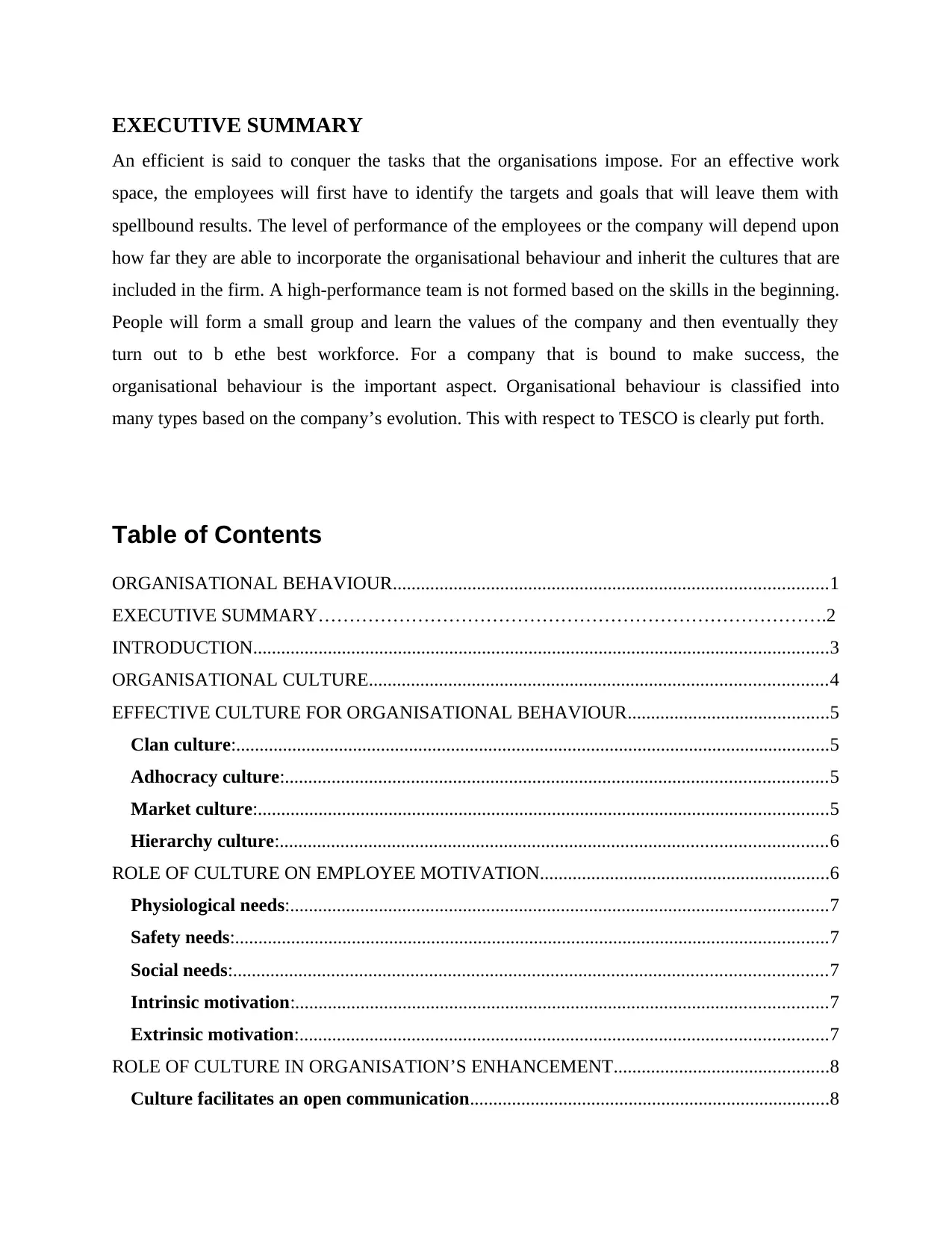
EXECUTIVE SUMMARY
An efficient is said to conquer the tasks that the organisations impose. For an effective work
space, the employees will first have to identify the targets and goals that will leave them with
spellbound results. The level of performance of the employees or the company will depend upon
how far they are able to incorporate the organisational behaviour and inherit the cultures that are
included in the firm. A high-performance team is not formed based on the skills in the beginning.
People will form a small group and learn the values of the company and then eventually they
turn out to b ethe best workforce. For a company that is bound to make success, the
organisational behaviour is the important aspect. Organisational behaviour is classified into
many types based on the company’s evolution. This with respect to TESCO is clearly put forth.
Table of Contents
ORGANISATIONAL BEHAVIOUR.............................................................................................1
EXECUTIVE SUMMARY……………………………………………………………………….2
INTRODUCTION...........................................................................................................................3
ORGANISATIONAL CULTURE..................................................................................................4
EFFECTIVE CULTURE FOR ORGANISATIONAL BEHAVIOUR...........................................5
Clan culture:...............................................................................................................................5
Adhocracy culture:....................................................................................................................5
Market culture:..........................................................................................................................5
Hierarchy culture:.....................................................................................................................6
ROLE OF CULTURE ON EMPLOYEE MOTIVATION..............................................................6
Physiological needs:...................................................................................................................7
Safety needs:...............................................................................................................................7
Social needs:...............................................................................................................................7
Intrinsic motivation:..................................................................................................................7
Extrinsic motivation:.................................................................................................................7
ROLE OF CULTURE IN ORGANISATION’S ENHANCEMENT..............................................8
Culture facilitates an open communication.............................................................................8
An efficient is said to conquer the tasks that the organisations impose. For an effective work
space, the employees will first have to identify the targets and goals that will leave them with
spellbound results. The level of performance of the employees or the company will depend upon
how far they are able to incorporate the organisational behaviour and inherit the cultures that are
included in the firm. A high-performance team is not formed based on the skills in the beginning.
People will form a small group and learn the values of the company and then eventually they
turn out to b ethe best workforce. For a company that is bound to make success, the
organisational behaviour is the important aspect. Organisational behaviour is classified into
many types based on the company’s evolution. This with respect to TESCO is clearly put forth.
Table of Contents
ORGANISATIONAL BEHAVIOUR.............................................................................................1
EXECUTIVE SUMMARY……………………………………………………………………….2
INTRODUCTION...........................................................................................................................3
ORGANISATIONAL CULTURE..................................................................................................4
EFFECTIVE CULTURE FOR ORGANISATIONAL BEHAVIOUR...........................................5
Clan culture:...............................................................................................................................5
Adhocracy culture:....................................................................................................................5
Market culture:..........................................................................................................................5
Hierarchy culture:.....................................................................................................................6
ROLE OF CULTURE ON EMPLOYEE MOTIVATION..............................................................6
Physiological needs:...................................................................................................................7
Safety needs:...............................................................................................................................7
Social needs:...............................................................................................................................7
Intrinsic motivation:..................................................................................................................7
Extrinsic motivation:.................................................................................................................7
ROLE OF CULTURE IN ORGANISATION’S ENHANCEMENT..............................................8
Culture facilitates an open communication.............................................................................8
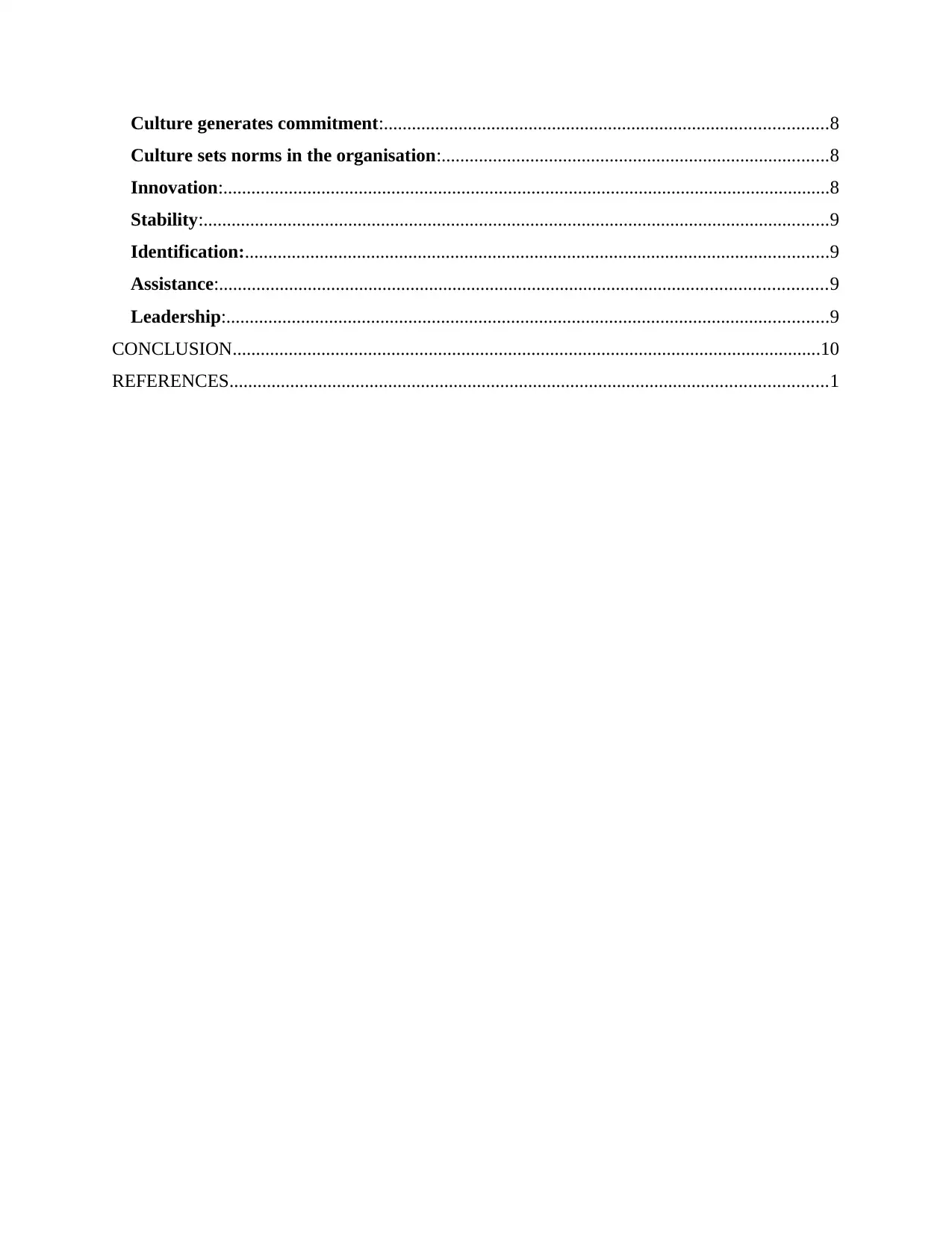
Culture generates commitment:...............................................................................................8
Culture sets norms in the organisation:...................................................................................8
Innovation:..................................................................................................................................8
Stability:......................................................................................................................................9
Identification:.............................................................................................................................9
Assistance:..................................................................................................................................9
Leadership:.................................................................................................................................9
CONCLUSION..............................................................................................................................10
REFERENCES................................................................................................................................1
Culture sets norms in the organisation:...................................................................................8
Innovation:..................................................................................................................................8
Stability:......................................................................................................................................9
Identification:.............................................................................................................................9
Assistance:..................................................................................................................................9
Leadership:.................................................................................................................................9
CONCLUSION..............................................................................................................................10
REFERENCES................................................................................................................................1
⊘ This is a preview!⊘
Do you want full access?
Subscribe today to unlock all pages.

Trusted by 1+ million students worldwide
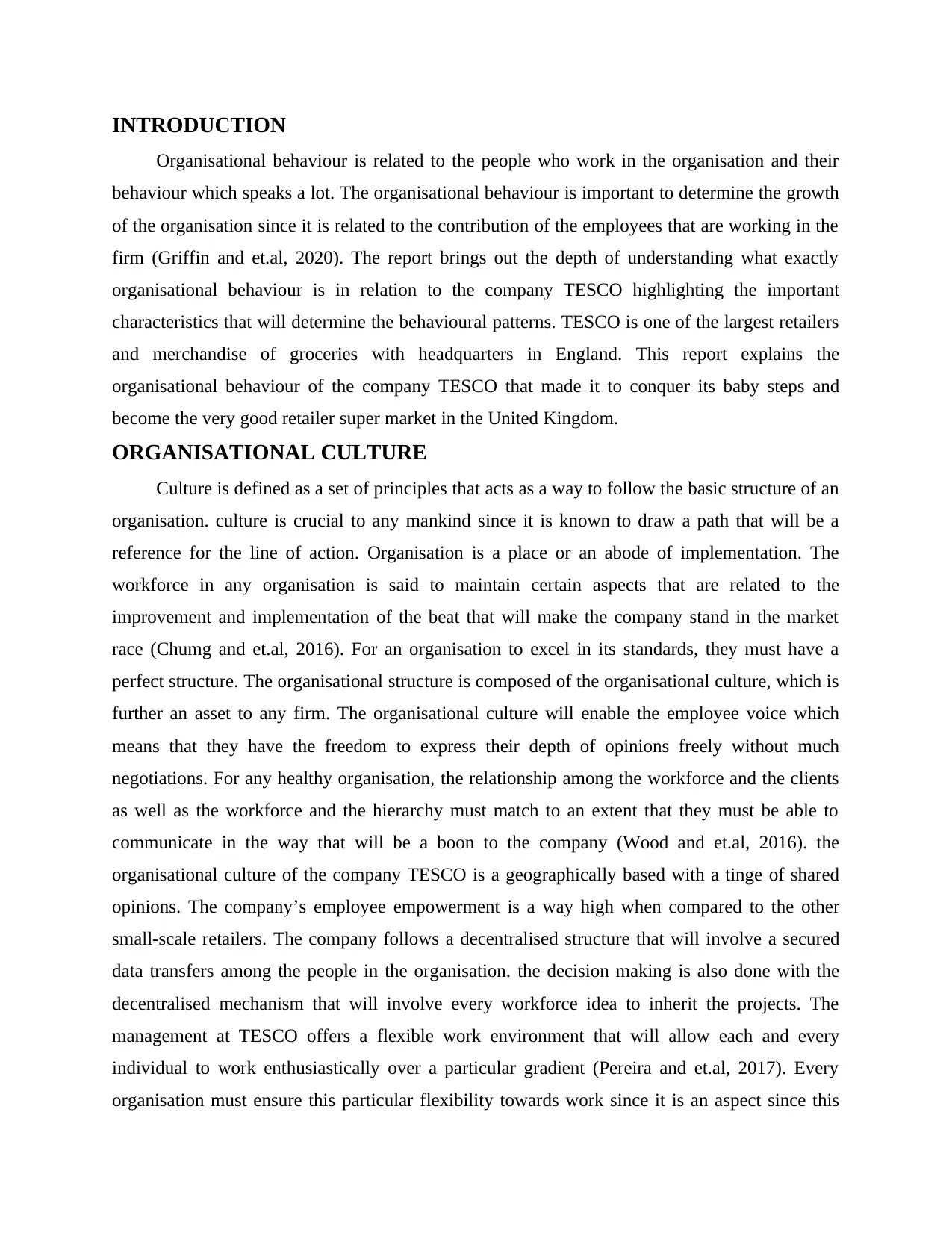
INTRODUCTION
Organisational behaviour is related to the people who work in the organisation and their
behaviour which speaks a lot. The organisational behaviour is important to determine the growth
of the organisation since it is related to the contribution of the employees that are working in the
firm (Griffin and et.al, 2020). The report brings out the depth of understanding what exactly
organisational behaviour is in relation to the company TESCO highlighting the important
characteristics that will determine the behavioural patterns. TESCO is one of the largest retailers
and merchandise of groceries with headquarters in England. This report explains the
organisational behaviour of the company TESCO that made it to conquer its baby steps and
become the very good retailer super market in the United Kingdom.
ORGANISATIONAL CULTURE
Culture is defined as a set of principles that acts as a way to follow the basic structure of an
organisation. culture is crucial to any mankind since it is known to draw a path that will be a
reference for the line of action. Organisation is a place or an abode of implementation. The
workforce in any organisation is said to maintain certain aspects that are related to the
improvement and implementation of the beat that will make the company stand in the market
race (Chumg and et.al, 2016). For an organisation to excel in its standards, they must have a
perfect structure. The organisational structure is composed of the organisational culture, which is
further an asset to any firm. The organisational culture will enable the employee voice which
means that they have the freedom to express their depth of opinions freely without much
negotiations. For any healthy organisation, the relationship among the workforce and the clients
as well as the workforce and the hierarchy must match to an extent that they must be able to
communicate in the way that will be a boon to the company (Wood and et.al, 2016). the
organisational culture of the company TESCO is a geographically based with a tinge of shared
opinions. The company’s employee empowerment is a way high when compared to the other
small-scale retailers. The company follows a decentralised structure that will involve a secured
data transfers among the people in the organisation. the decision making is also done with the
decentralised mechanism that will involve every workforce idea to inherit the projects. The
management at TESCO offers a flexible work environment that will allow each and every
individual to work enthusiastically over a particular gradient (Pereira and et.al, 2017). Every
organisation must ensure this particular flexibility towards work since it is an aspect since this
Organisational behaviour is related to the people who work in the organisation and their
behaviour which speaks a lot. The organisational behaviour is important to determine the growth
of the organisation since it is related to the contribution of the employees that are working in the
firm (Griffin and et.al, 2020). The report brings out the depth of understanding what exactly
organisational behaviour is in relation to the company TESCO highlighting the important
characteristics that will determine the behavioural patterns. TESCO is one of the largest retailers
and merchandise of groceries with headquarters in England. This report explains the
organisational behaviour of the company TESCO that made it to conquer its baby steps and
become the very good retailer super market in the United Kingdom.
ORGANISATIONAL CULTURE
Culture is defined as a set of principles that acts as a way to follow the basic structure of an
organisation. culture is crucial to any mankind since it is known to draw a path that will be a
reference for the line of action. Organisation is a place or an abode of implementation. The
workforce in any organisation is said to maintain certain aspects that are related to the
improvement and implementation of the beat that will make the company stand in the market
race (Chumg and et.al, 2016). For an organisation to excel in its standards, they must have a
perfect structure. The organisational structure is composed of the organisational culture, which is
further an asset to any firm. The organisational culture will enable the employee voice which
means that they have the freedom to express their depth of opinions freely without much
negotiations. For any healthy organisation, the relationship among the workforce and the clients
as well as the workforce and the hierarchy must match to an extent that they must be able to
communicate in the way that will be a boon to the company (Wood and et.al, 2016). the
organisational culture of the company TESCO is a geographically based with a tinge of shared
opinions. The company’s employee empowerment is a way high when compared to the other
small-scale retailers. The company follows a decentralised structure that will involve a secured
data transfers among the people in the organisation. the decision making is also done with the
decentralised mechanism that will involve every workforce idea to inherit the projects. The
management at TESCO offers a flexible work environment that will allow each and every
individual to work enthusiastically over a particular gradient (Pereira and et.al, 2017). Every
organisation must ensure this particular flexibility towards work since it is an aspect since this
Paraphrase This Document
Need a fresh take? Get an instant paraphrase of this document with our AI Paraphraser
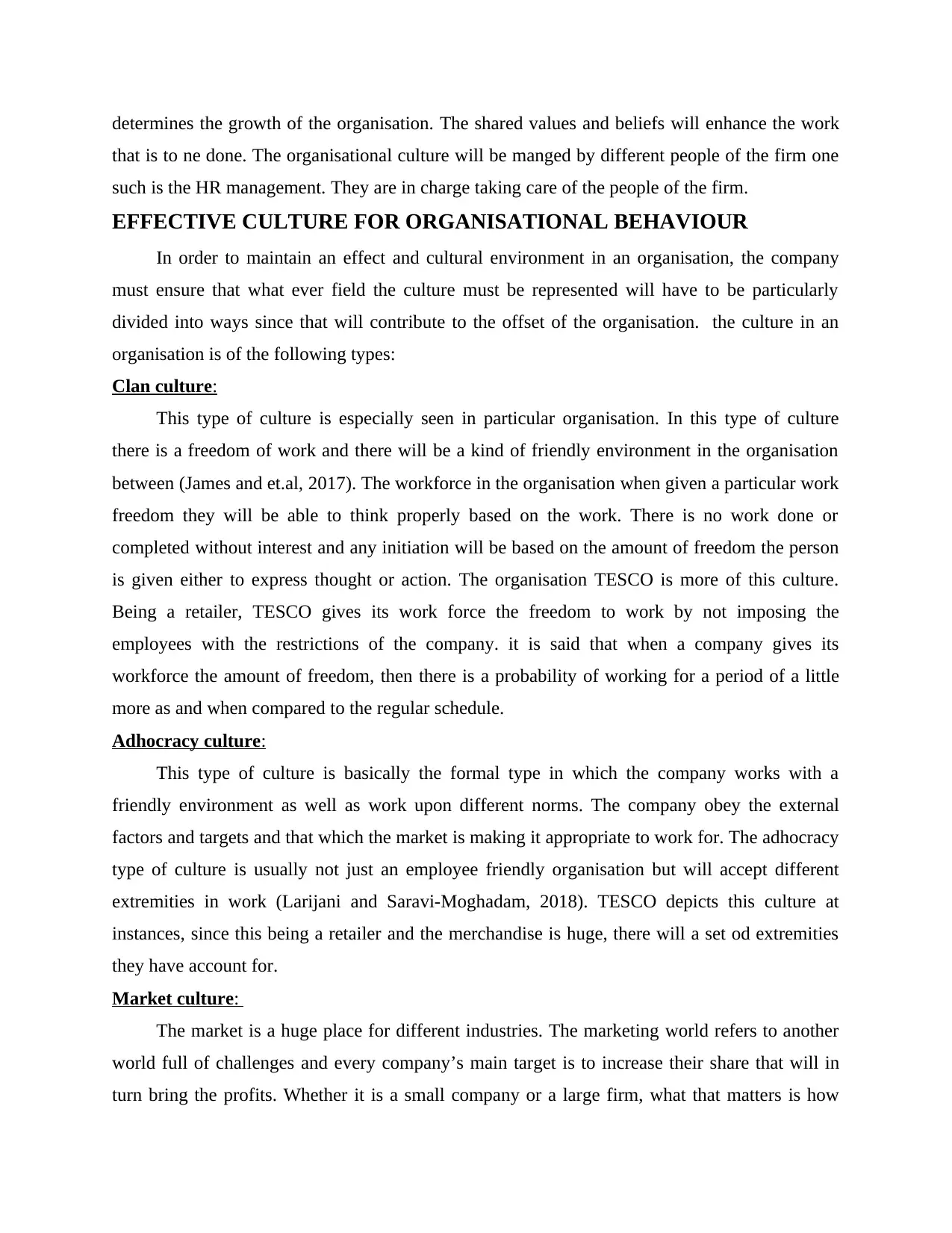
determines the growth of the organisation. The shared values and beliefs will enhance the work
that is to ne done. The organisational culture will be manged by different people of the firm one
such is the HR management. They are in charge taking care of the people of the firm.
EFFECTIVE CULTURE FOR ORGANISATIONAL BEHAVIOUR
In order to maintain an effect and cultural environment in an organisation, the company
must ensure that what ever field the culture must be represented will have to be particularly
divided into ways since that will contribute to the offset of the organisation. the culture in an
organisation is of the following types:
Clan culture:
This type of culture is especially seen in particular organisation. In this type of culture
there is a freedom of work and there will be a kind of friendly environment in the organisation
between (James and et.al, 2017). The workforce in the organisation when given a particular work
freedom they will be able to think properly based on the work. There is no work done or
completed without interest and any initiation will be based on the amount of freedom the person
is given either to express thought or action. The organisation TESCO is more of this culture.
Being a retailer, TESCO gives its work force the freedom to work by not imposing the
employees with the restrictions of the company. it is said that when a company gives its
workforce the amount of freedom, then there is a probability of working for a period of a little
more as and when compared to the regular schedule.
Adhocracy culture:
This type of culture is basically the formal type in which the company works with a
friendly environment as well as work upon different norms. The company obey the external
factors and targets and that which the market is making it appropriate to work for. The adhocracy
type of culture is usually not just an employee friendly organisation but will accept different
extremities in work (Larijani and Saravi-Moghadam, 2018). TESCO depicts this culture at
instances, since this being a retailer and the merchandise is huge, there will a set od extremities
they have account for.
Market culture:
The market is a huge place for different industries. The marketing world refers to another
world full of challenges and every company’s main target is to increase their share that will in
turn bring the profits. Whether it is a small company or a large firm, what that matters is how
that is to ne done. The organisational culture will be manged by different people of the firm one
such is the HR management. They are in charge taking care of the people of the firm.
EFFECTIVE CULTURE FOR ORGANISATIONAL BEHAVIOUR
In order to maintain an effect and cultural environment in an organisation, the company
must ensure that what ever field the culture must be represented will have to be particularly
divided into ways since that will contribute to the offset of the organisation. the culture in an
organisation is of the following types:
Clan culture:
This type of culture is especially seen in particular organisation. In this type of culture
there is a freedom of work and there will be a kind of friendly environment in the organisation
between (James and et.al, 2017). The workforce in the organisation when given a particular work
freedom they will be able to think properly based on the work. There is no work done or
completed without interest and any initiation will be based on the amount of freedom the person
is given either to express thought or action. The organisation TESCO is more of this culture.
Being a retailer, TESCO gives its work force the freedom to work by not imposing the
employees with the restrictions of the company. it is said that when a company gives its
workforce the amount of freedom, then there is a probability of working for a period of a little
more as and when compared to the regular schedule.
Adhocracy culture:
This type of culture is basically the formal type in which the company works with a
friendly environment as well as work upon different norms. The company obey the external
factors and targets and that which the market is making it appropriate to work for. The adhocracy
type of culture is usually not just an employee friendly organisation but will accept different
extremities in work (Larijani and Saravi-Moghadam, 2018). TESCO depicts this culture at
instances, since this being a retailer and the merchandise is huge, there will a set od extremities
they have account for.
Market culture:
The market is a huge place for different industries. The marketing world refers to another
world full of challenges and every company’s main target is to increase their share that will in
turn bring the profits. Whether it is a small company or a large firm, what that matters is how
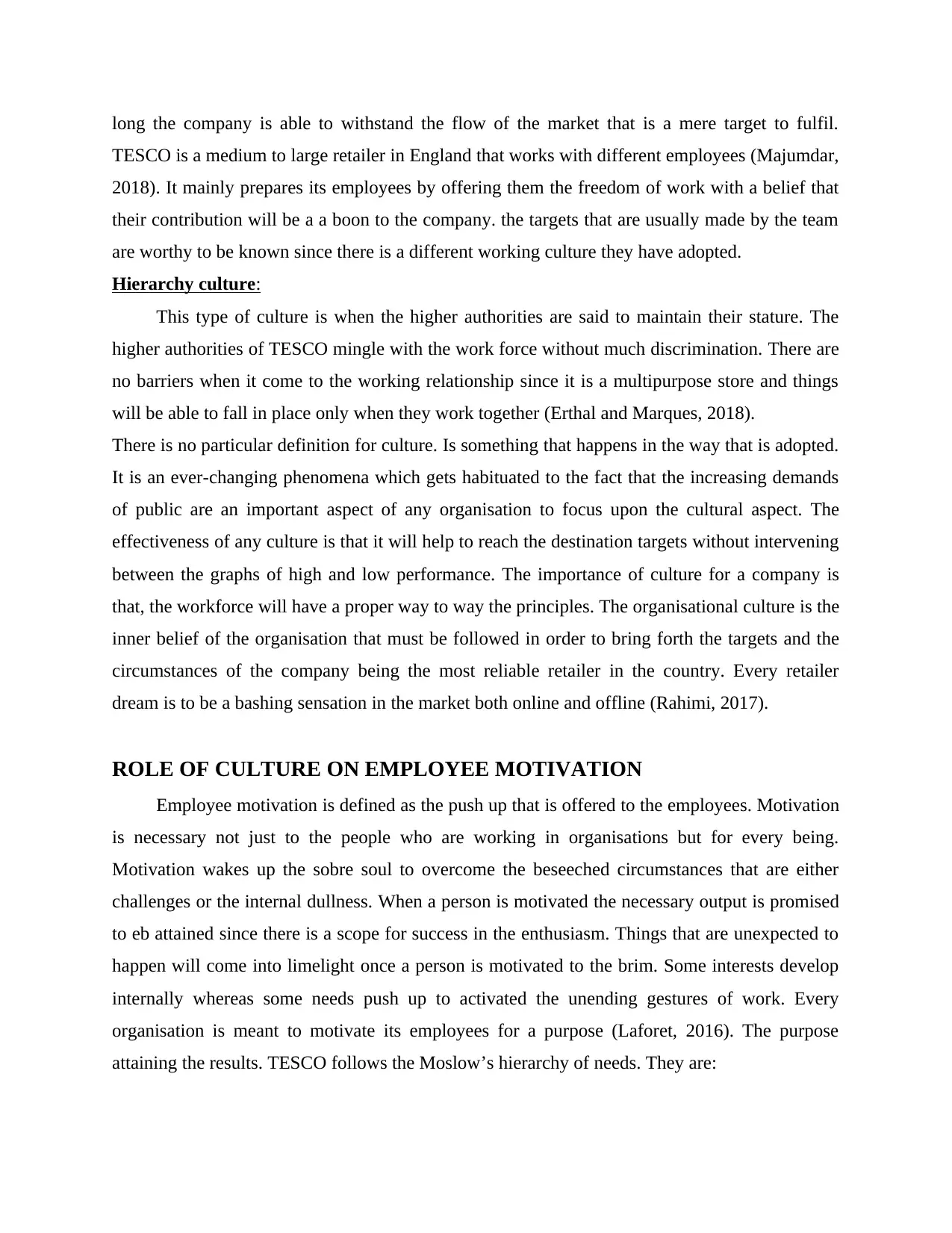
long the company is able to withstand the flow of the market that is a mere target to fulfil.
TESCO is a medium to large retailer in England that works with different employees (Majumdar,
2018). It mainly prepares its employees by offering them the freedom of work with a belief that
their contribution will be a a boon to the company. the targets that are usually made by the team
are worthy to be known since there is a different working culture they have adopted.
Hierarchy culture:
This type of culture is when the higher authorities are said to maintain their stature. The
higher authorities of TESCO mingle with the work force without much discrimination. There are
no barriers when it come to the working relationship since it is a multipurpose store and things
will be able to fall in place only when they work together (Erthal and Marques, 2018).
There is no particular definition for culture. Is something that happens in the way that is adopted.
It is an ever-changing phenomena which gets habituated to the fact that the increasing demands
of public are an important aspect of any organisation to focus upon the cultural aspect. The
effectiveness of any culture is that it will help to reach the destination targets without intervening
between the graphs of high and low performance. The importance of culture for a company is
that, the workforce will have a proper way to way the principles. The organisational culture is the
inner belief of the organisation that must be followed in order to bring forth the targets and the
circumstances of the company being the most reliable retailer in the country. Every retailer
dream is to be a bashing sensation in the market both online and offline (Rahimi, 2017).
ROLE OF CULTURE ON EMPLOYEE MOTIVATION
Employee motivation is defined as the push up that is offered to the employees. Motivation
is necessary not just to the people who are working in organisations but for every being.
Motivation wakes up the sobre soul to overcome the beseeched circumstances that are either
challenges or the internal dullness. When a person is motivated the necessary output is promised
to eb attained since there is a scope for success in the enthusiasm. Things that are unexpected to
happen will come into limelight once a person is motivated to the brim. Some interests develop
internally whereas some needs push up to activated the unending gestures of work. Every
organisation is meant to motivate its employees for a purpose (Laforet, 2016). The purpose
attaining the results. TESCO follows the Moslow’s hierarchy of needs. They are:
TESCO is a medium to large retailer in England that works with different employees (Majumdar,
2018). It mainly prepares its employees by offering them the freedom of work with a belief that
their contribution will be a a boon to the company. the targets that are usually made by the team
are worthy to be known since there is a different working culture they have adopted.
Hierarchy culture:
This type of culture is when the higher authorities are said to maintain their stature. The
higher authorities of TESCO mingle with the work force without much discrimination. There are
no barriers when it come to the working relationship since it is a multipurpose store and things
will be able to fall in place only when they work together (Erthal and Marques, 2018).
There is no particular definition for culture. Is something that happens in the way that is adopted.
It is an ever-changing phenomena which gets habituated to the fact that the increasing demands
of public are an important aspect of any organisation to focus upon the cultural aspect. The
effectiveness of any culture is that it will help to reach the destination targets without intervening
between the graphs of high and low performance. The importance of culture for a company is
that, the workforce will have a proper way to way the principles. The organisational culture is the
inner belief of the organisation that must be followed in order to bring forth the targets and the
circumstances of the company being the most reliable retailer in the country. Every retailer
dream is to be a bashing sensation in the market both online and offline (Rahimi, 2017).
ROLE OF CULTURE ON EMPLOYEE MOTIVATION
Employee motivation is defined as the push up that is offered to the employees. Motivation
is necessary not just to the people who are working in organisations but for every being.
Motivation wakes up the sobre soul to overcome the beseeched circumstances that are either
challenges or the internal dullness. When a person is motivated the necessary output is promised
to eb attained since there is a scope for success in the enthusiasm. Things that are unexpected to
happen will come into limelight once a person is motivated to the brim. Some interests develop
internally whereas some needs push up to activated the unending gestures of work. Every
organisation is meant to motivate its employees for a purpose (Laforet, 2016). The purpose
attaining the results. TESCO follows the Moslow’s hierarchy of needs. They are:
⊘ This is a preview!⊘
Do you want full access?
Subscribe today to unlock all pages.

Trusted by 1+ million students worldwide
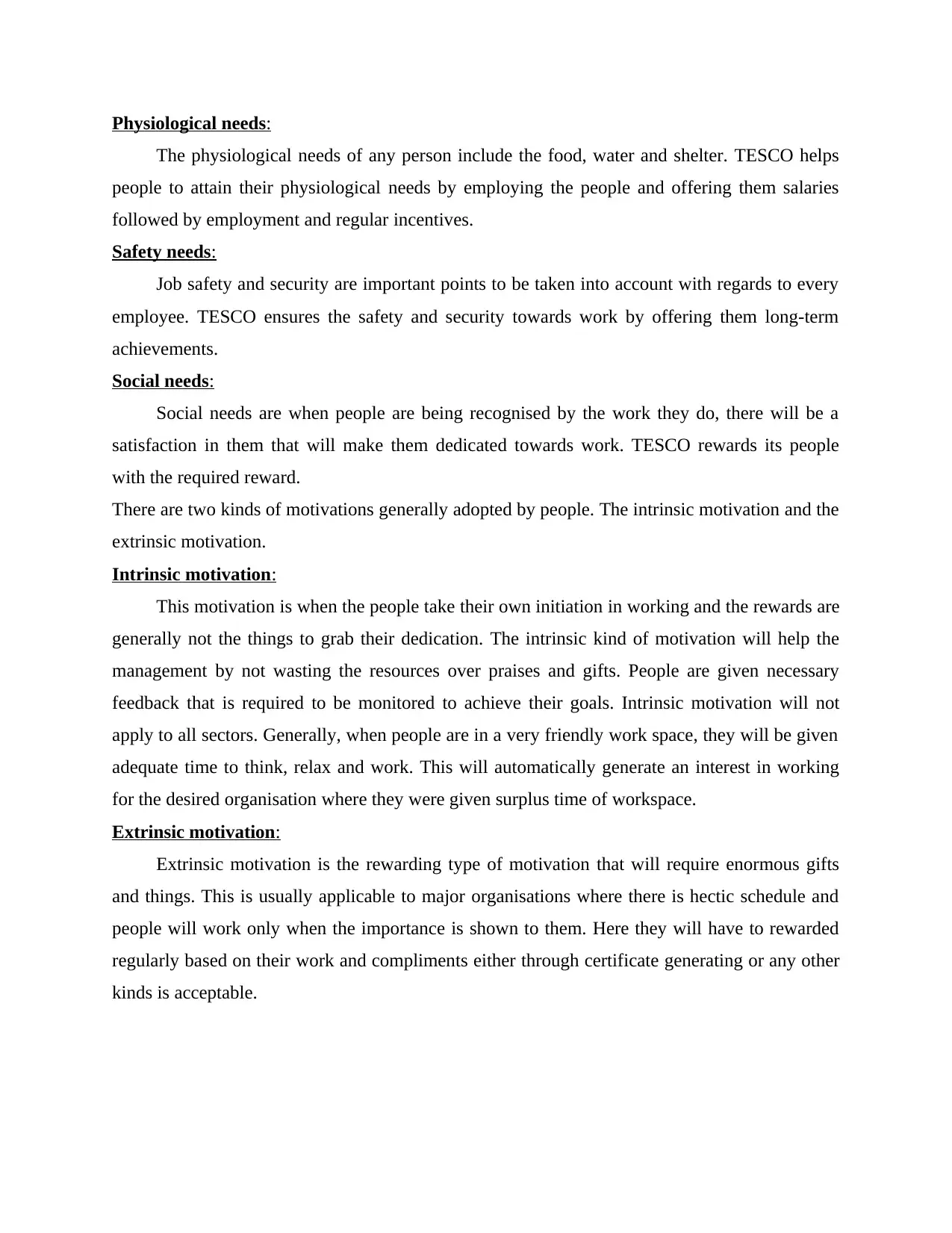
Physiological needs:
The physiological needs of any person include the food, water and shelter. TESCO helps
people to attain their physiological needs by employing the people and offering them salaries
followed by employment and regular incentives.
Safety needs:
Job safety and security are important points to be taken into account with regards to every
employee. TESCO ensures the safety and security towards work by offering them long-term
achievements.
Social needs:
Social needs are when people are being recognised by the work they do, there will be a
satisfaction in them that will make them dedicated towards work. TESCO rewards its people
with the required reward.
There are two kinds of motivations generally adopted by people. The intrinsic motivation and the
extrinsic motivation.
Intrinsic motivation:
This motivation is when the people take their own initiation in working and the rewards are
generally not the things to grab their dedication. The intrinsic kind of motivation will help the
management by not wasting the resources over praises and gifts. People are given necessary
feedback that is required to be monitored to achieve their goals. Intrinsic motivation will not
apply to all sectors. Generally, when people are in a very friendly work space, they will be given
adequate time to think, relax and work. This will automatically generate an interest in working
for the desired organisation where they were given surplus time of workspace.
Extrinsic motivation:
Extrinsic motivation is the rewarding type of motivation that will require enormous gifts
and things. This is usually applicable to major organisations where there is hectic schedule and
people will work only when the importance is shown to them. Here they will have to rewarded
regularly based on their work and compliments either through certificate generating or any other
kinds is acceptable.
The physiological needs of any person include the food, water and shelter. TESCO helps
people to attain their physiological needs by employing the people and offering them salaries
followed by employment and regular incentives.
Safety needs:
Job safety and security are important points to be taken into account with regards to every
employee. TESCO ensures the safety and security towards work by offering them long-term
achievements.
Social needs:
Social needs are when people are being recognised by the work they do, there will be a
satisfaction in them that will make them dedicated towards work. TESCO rewards its people
with the required reward.
There are two kinds of motivations generally adopted by people. The intrinsic motivation and the
extrinsic motivation.
Intrinsic motivation:
This motivation is when the people take their own initiation in working and the rewards are
generally not the things to grab their dedication. The intrinsic kind of motivation will help the
management by not wasting the resources over praises and gifts. People are given necessary
feedback that is required to be monitored to achieve their goals. Intrinsic motivation will not
apply to all sectors. Generally, when people are in a very friendly work space, they will be given
adequate time to think, relax and work. This will automatically generate an interest in working
for the desired organisation where they were given surplus time of workspace.
Extrinsic motivation:
Extrinsic motivation is the rewarding type of motivation that will require enormous gifts
and things. This is usually applicable to major organisations where there is hectic schedule and
people will work only when the importance is shown to them. Here they will have to rewarded
regularly based on their work and compliments either through certificate generating or any other
kinds is acceptable.
Paraphrase This Document
Need a fresh take? Get an instant paraphrase of this document with our AI Paraphraser
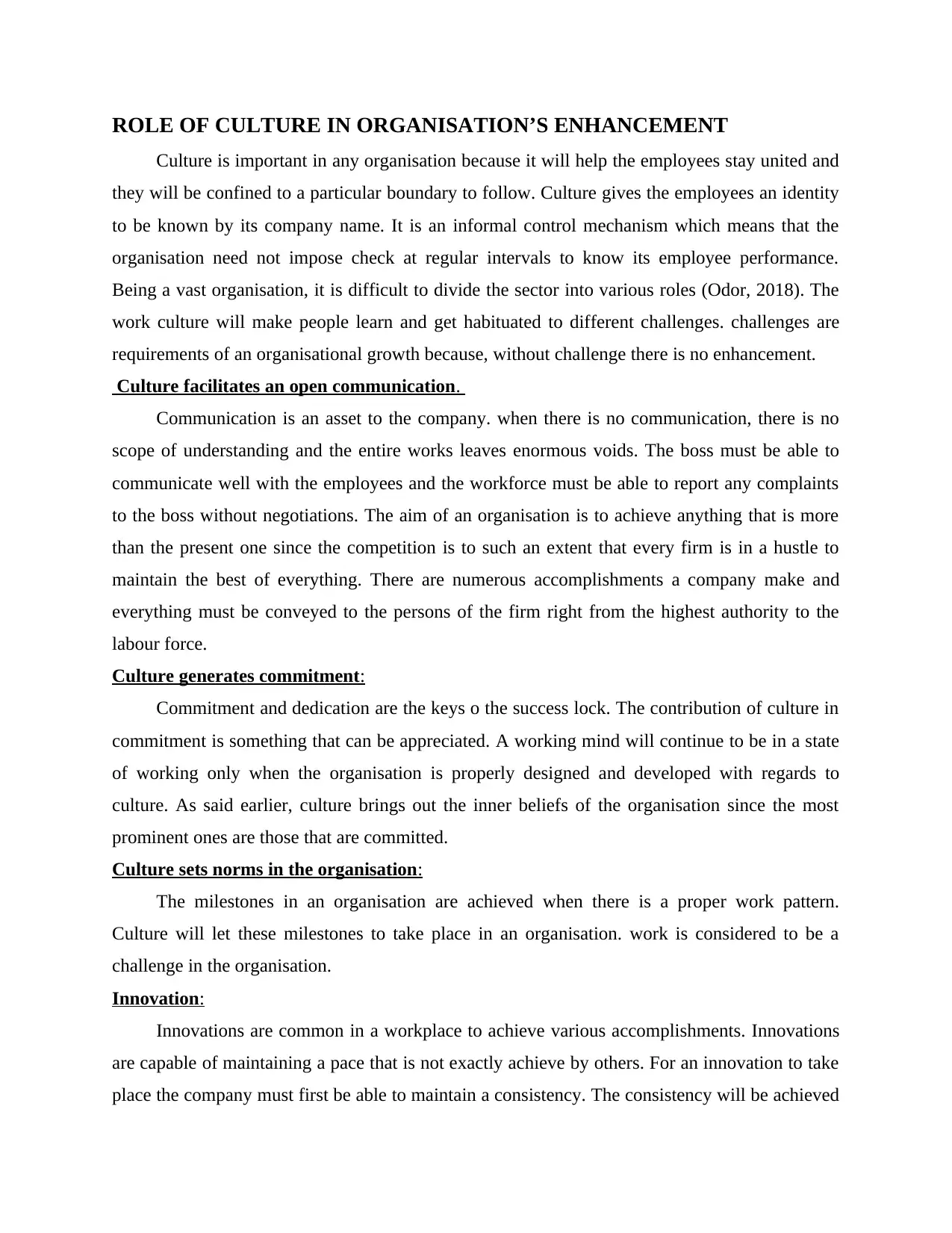
ROLE OF CULTURE IN ORGANISATION’S ENHANCEMENT
Culture is important in any organisation because it will help the employees stay united and
they will be confined to a particular boundary to follow. Culture gives the employees an identity
to be known by its company name. It is an informal control mechanism which means that the
organisation need not impose check at regular intervals to know its employee performance.
Being a vast organisation, it is difficult to divide the sector into various roles (Odor, 2018). The
work culture will make people learn and get habituated to different challenges. challenges are
requirements of an organisational growth because, without challenge there is no enhancement.
Culture facilitates an open communication.
Communication is an asset to the company. when there is no communication, there is no
scope of understanding and the entire works leaves enormous voids. The boss must be able to
communicate well with the employees and the workforce must be able to report any complaints
to the boss without negotiations. The aim of an organisation is to achieve anything that is more
than the present one since the competition is to such an extent that every firm is in a hustle to
maintain the best of everything. There are numerous accomplishments a company make and
everything must be conveyed to the persons of the firm right from the highest authority to the
labour force.
Culture generates commitment:
Commitment and dedication are the keys o the success lock. The contribution of culture in
commitment is something that can be appreciated. A working mind will continue to be in a state
of working only when the organisation is properly designed and developed with regards to
culture. As said earlier, culture brings out the inner beliefs of the organisation since the most
prominent ones are those that are committed.
Culture sets norms in the organisation:
The milestones in an organisation are achieved when there is a proper work pattern.
Culture will let these milestones to take place in an organisation. work is considered to be a
challenge in the organisation.
Innovation:
Innovations are common in a workplace to achieve various accomplishments. Innovations
are capable of maintaining a pace that is not exactly achieve by others. For an innovation to take
place the company must first be able to maintain a consistency. The consistency will be achieved
Culture is important in any organisation because it will help the employees stay united and
they will be confined to a particular boundary to follow. Culture gives the employees an identity
to be known by its company name. It is an informal control mechanism which means that the
organisation need not impose check at regular intervals to know its employee performance.
Being a vast organisation, it is difficult to divide the sector into various roles (Odor, 2018). The
work culture will make people learn and get habituated to different challenges. challenges are
requirements of an organisational growth because, without challenge there is no enhancement.
Culture facilitates an open communication.
Communication is an asset to the company. when there is no communication, there is no
scope of understanding and the entire works leaves enormous voids. The boss must be able to
communicate well with the employees and the workforce must be able to report any complaints
to the boss without negotiations. The aim of an organisation is to achieve anything that is more
than the present one since the competition is to such an extent that every firm is in a hustle to
maintain the best of everything. There are numerous accomplishments a company make and
everything must be conveyed to the persons of the firm right from the highest authority to the
labour force.
Culture generates commitment:
Commitment and dedication are the keys o the success lock. The contribution of culture in
commitment is something that can be appreciated. A working mind will continue to be in a state
of working only when the organisation is properly designed and developed with regards to
culture. As said earlier, culture brings out the inner beliefs of the organisation since the most
prominent ones are those that are committed.
Culture sets norms in the organisation:
The milestones in an organisation are achieved when there is a proper work pattern.
Culture will let these milestones to take place in an organisation. work is considered to be a
challenge in the organisation.
Innovation:
Innovations are common in a workplace to achieve various accomplishments. Innovations
are capable of maintaining a pace that is not exactly achieve by others. For an innovation to take
place the company must first be able to maintain a consistency. The consistency will be achieved
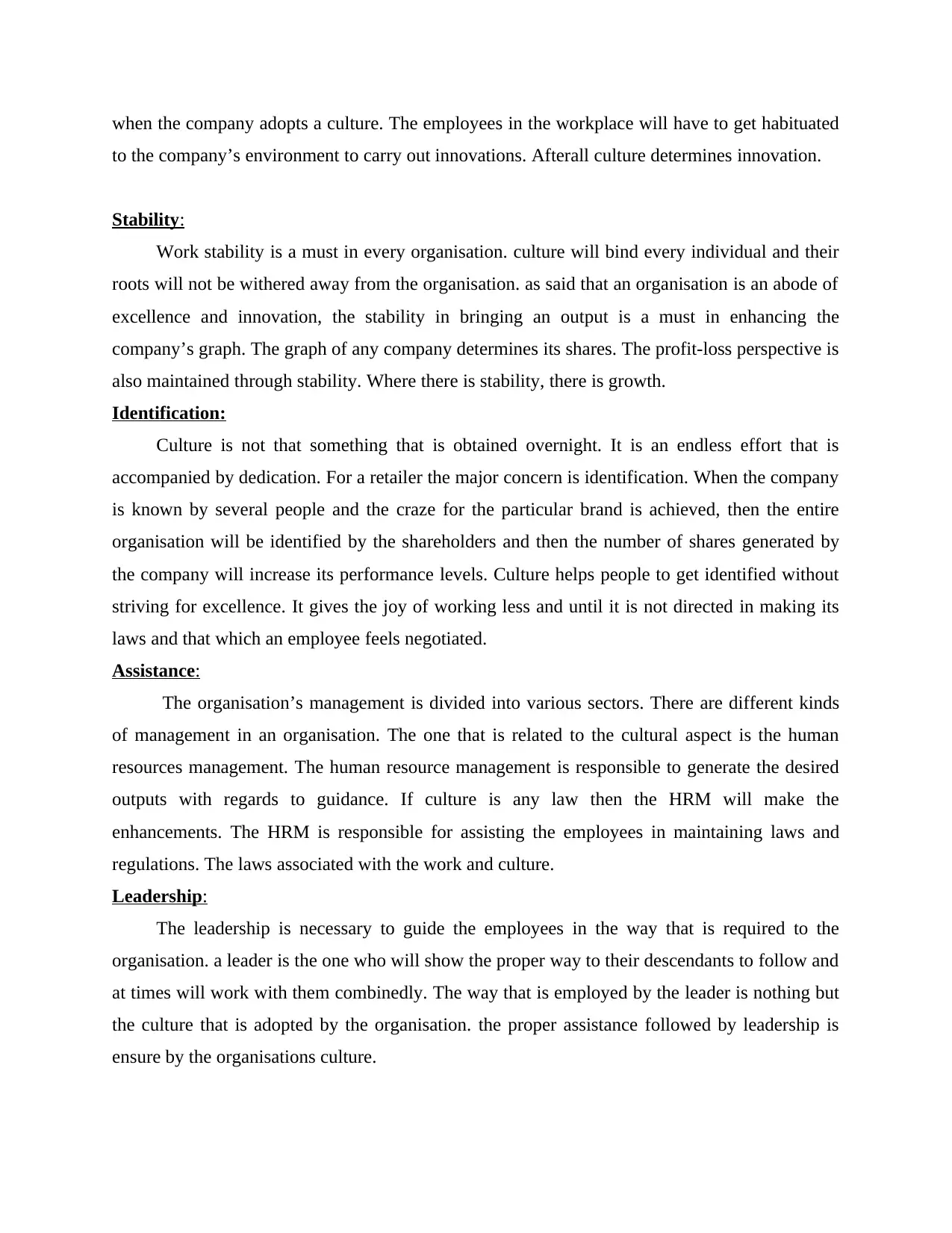
when the company adopts a culture. The employees in the workplace will have to get habituated
to the company’s environment to carry out innovations. Afterall culture determines innovation.
Stability:
Work stability is a must in every organisation. culture will bind every individual and their
roots will not be withered away from the organisation. as said that an organisation is an abode of
excellence and innovation, the stability in bringing an output is a must in enhancing the
company’s graph. The graph of any company determines its shares. The profit-loss perspective is
also maintained through stability. Where there is stability, there is growth.
Identification:
Culture is not that something that is obtained overnight. It is an endless effort that is
accompanied by dedication. For a retailer the major concern is identification. When the company
is known by several people and the craze for the particular brand is achieved, then the entire
organisation will be identified by the shareholders and then the number of shares generated by
the company will increase its performance levels. Culture helps people to get identified without
striving for excellence. It gives the joy of working less and until it is not directed in making its
laws and that which an employee feels negotiated.
Assistance:
The organisation’s management is divided into various sectors. There are different kinds
of management in an organisation. The one that is related to the cultural aspect is the human
resources management. The human resource management is responsible to generate the desired
outputs with regards to guidance. If culture is any law then the HRM will make the
enhancements. The HRM is responsible for assisting the employees in maintaining laws and
regulations. The laws associated with the work and culture.
Leadership:
The leadership is necessary to guide the employees in the way that is required to the
organisation. a leader is the one who will show the proper way to their descendants to follow and
at times will work with them combinedly. The way that is employed by the leader is nothing but
the culture that is adopted by the organisation. the proper assistance followed by leadership is
ensure by the organisations culture.
to the company’s environment to carry out innovations. Afterall culture determines innovation.
Stability:
Work stability is a must in every organisation. culture will bind every individual and their
roots will not be withered away from the organisation. as said that an organisation is an abode of
excellence and innovation, the stability in bringing an output is a must in enhancing the
company’s graph. The graph of any company determines its shares. The profit-loss perspective is
also maintained through stability. Where there is stability, there is growth.
Identification:
Culture is not that something that is obtained overnight. It is an endless effort that is
accompanied by dedication. For a retailer the major concern is identification. When the company
is known by several people and the craze for the particular brand is achieved, then the entire
organisation will be identified by the shareholders and then the number of shares generated by
the company will increase its performance levels. Culture helps people to get identified without
striving for excellence. It gives the joy of working less and until it is not directed in making its
laws and that which an employee feels negotiated.
Assistance:
The organisation’s management is divided into various sectors. There are different kinds
of management in an organisation. The one that is related to the cultural aspect is the human
resources management. The human resource management is responsible to generate the desired
outputs with regards to guidance. If culture is any law then the HRM will make the
enhancements. The HRM is responsible for assisting the employees in maintaining laws and
regulations. The laws associated with the work and culture.
Leadership:
The leadership is necessary to guide the employees in the way that is required to the
organisation. a leader is the one who will show the proper way to their descendants to follow and
at times will work with them combinedly. The way that is employed by the leader is nothing but
the culture that is adopted by the organisation. the proper assistance followed by leadership is
ensure by the organisations culture.
⊘ This is a preview!⊘
Do you want full access?
Subscribe today to unlock all pages.

Trusted by 1+ million students worldwide
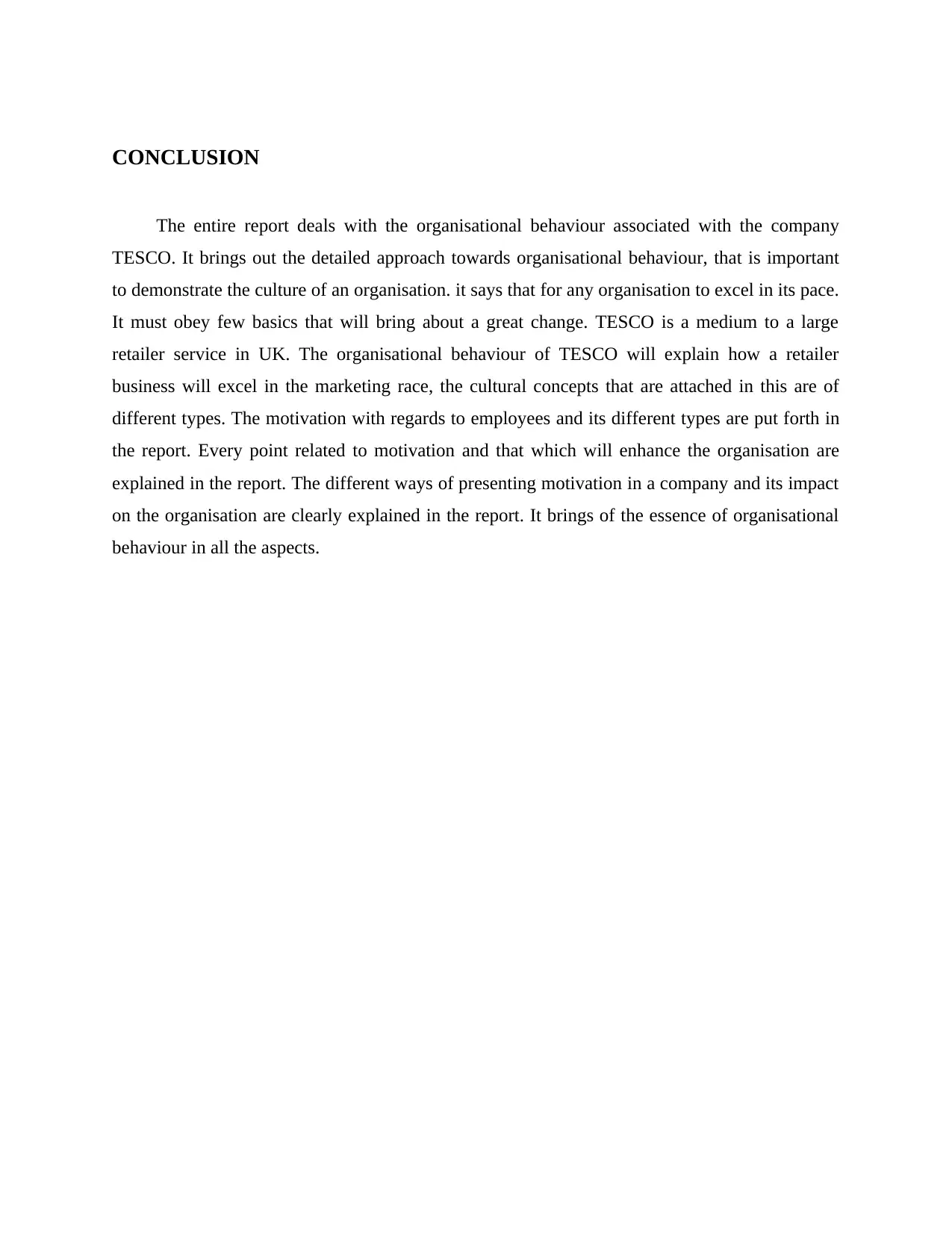
CONCLUSION
The entire report deals with the organisational behaviour associated with the company
TESCO. It brings out the detailed approach towards organisational behaviour, that is important
to demonstrate the culture of an organisation. it says that for any organisation to excel in its pace.
It must obey few basics that will bring about a great change. TESCO is a medium to a large
retailer service in UK. The organisational behaviour of TESCO will explain how a retailer
business will excel in the marketing race, the cultural concepts that are attached in this are of
different types. The motivation with regards to employees and its different types are put forth in
the report. Every point related to motivation and that which will enhance the organisation are
explained in the report. The different ways of presenting motivation in a company and its impact
on the organisation are clearly explained in the report. It brings of the essence of organisational
behaviour in all the aspects.
The entire report deals with the organisational behaviour associated with the company
TESCO. It brings out the detailed approach towards organisational behaviour, that is important
to demonstrate the culture of an organisation. it says that for any organisation to excel in its pace.
It must obey few basics that will bring about a great change. TESCO is a medium to a large
retailer service in UK. The organisational behaviour of TESCO will explain how a retailer
business will excel in the marketing race, the cultural concepts that are attached in this are of
different types. The motivation with regards to employees and its different types are put forth in
the report. Every point related to motivation and that which will enhance the organisation are
explained in the report. The different ways of presenting motivation in a company and its impact
on the organisation are clearly explained in the report. It brings of the essence of organisational
behaviour in all the aspects.
Paraphrase This Document
Need a fresh take? Get an instant paraphrase of this document with our AI Paraphraser
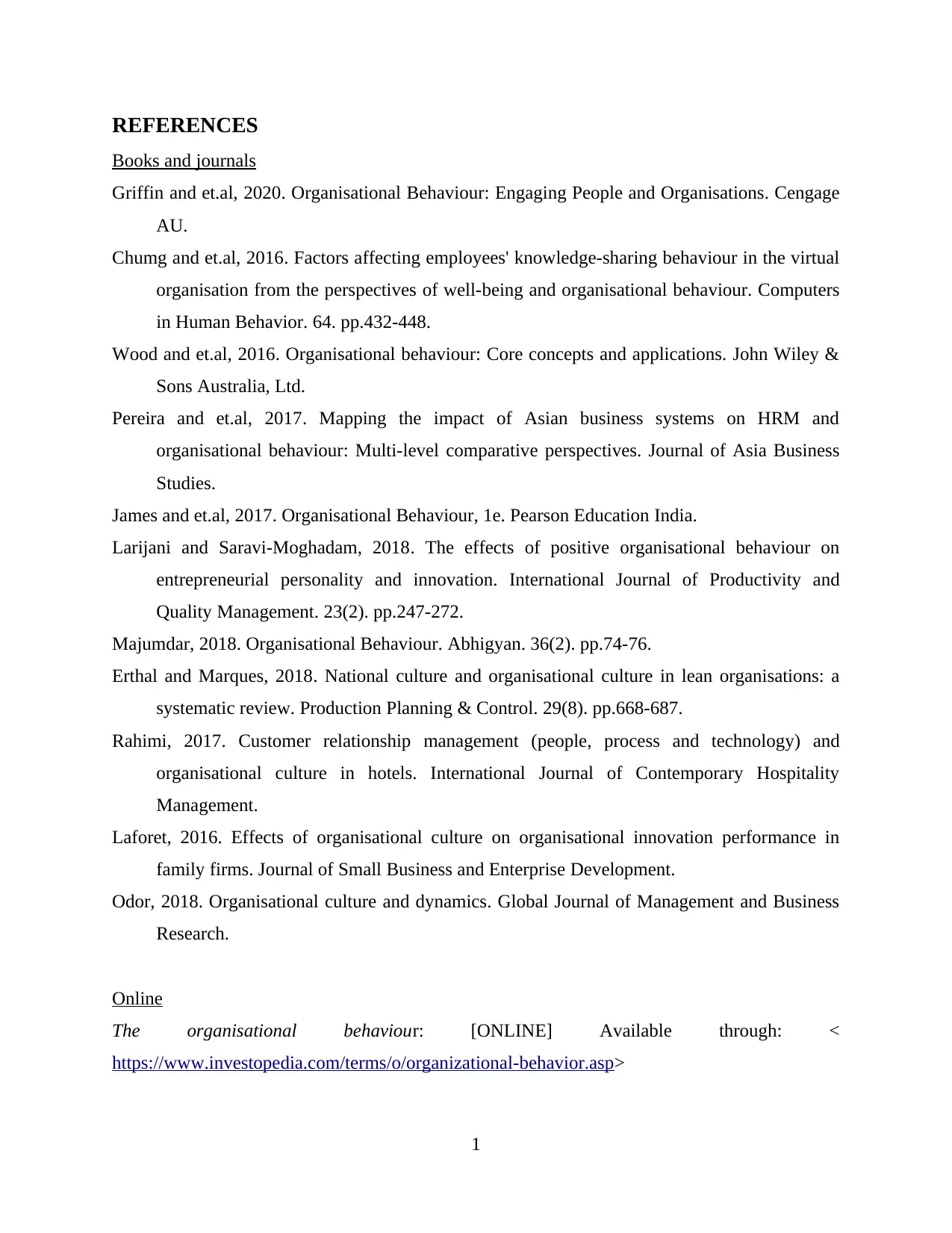
REFERENCES
Books and journals
Griffin and et.al, 2020. Organisational Behaviour: Engaging People and Organisations. Cengage
AU.
Chumg and et.al, 2016. Factors affecting employees' knowledge-sharing behaviour in the virtual
organisation from the perspectives of well-being and organisational behaviour. Computers
in Human Behavior. 64. pp.432-448.
Wood and et.al, 2016. Organisational behaviour: Core concepts and applications. John Wiley &
Sons Australia, Ltd.
Pereira and et.al, 2017. Mapping the impact of Asian business systems on HRM and
organisational behaviour: Multi-level comparative perspectives. Journal of Asia Business
Studies.
James and et.al, 2017. Organisational Behaviour, 1e. Pearson Education India.
Larijani and Saravi-Moghadam, 2018. The effects of positive organisational behaviour on
entrepreneurial personality and innovation. International Journal of Productivity and
Quality Management. 23(2). pp.247-272.
Majumdar, 2018. Organisational Behaviour. Abhigyan. 36(2). pp.74-76.
Erthal and Marques, 2018. National culture and organisational culture in lean organisations: a
systematic review. Production Planning & Control. 29(8). pp.668-687.
Rahimi, 2017. Customer relationship management (people, process and technology) and
organisational culture in hotels. International Journal of Contemporary Hospitality
Management.
Laforet, 2016. Effects of organisational culture on organisational innovation performance in
family firms. Journal of Small Business and Enterprise Development.
Odor, 2018. Organisational culture and dynamics. Global Journal of Management and Business
Research.
Online
The organisational behaviour: [ONLINE] Available through: <
https://www.investopedia.com/terms/o/organizational-behavior.asp>
1
Books and journals
Griffin and et.al, 2020. Organisational Behaviour: Engaging People and Organisations. Cengage
AU.
Chumg and et.al, 2016. Factors affecting employees' knowledge-sharing behaviour in the virtual
organisation from the perspectives of well-being and organisational behaviour. Computers
in Human Behavior. 64. pp.432-448.
Wood and et.al, 2016. Organisational behaviour: Core concepts and applications. John Wiley &
Sons Australia, Ltd.
Pereira and et.al, 2017. Mapping the impact of Asian business systems on HRM and
organisational behaviour: Multi-level comparative perspectives. Journal of Asia Business
Studies.
James and et.al, 2017. Organisational Behaviour, 1e. Pearson Education India.
Larijani and Saravi-Moghadam, 2018. The effects of positive organisational behaviour on
entrepreneurial personality and innovation. International Journal of Productivity and
Quality Management. 23(2). pp.247-272.
Majumdar, 2018. Organisational Behaviour. Abhigyan. 36(2). pp.74-76.
Erthal and Marques, 2018. National culture and organisational culture in lean organisations: a
systematic review. Production Planning & Control. 29(8). pp.668-687.
Rahimi, 2017. Customer relationship management (people, process and technology) and
organisational culture in hotels. International Journal of Contemporary Hospitality
Management.
Laforet, 2016. Effects of organisational culture on organisational innovation performance in
family firms. Journal of Small Business and Enterprise Development.
Odor, 2018. Organisational culture and dynamics. Global Journal of Management and Business
Research.
Online
The organisational behaviour: [ONLINE] Available through: <
https://www.investopedia.com/terms/o/organizational-behavior.asp>
1
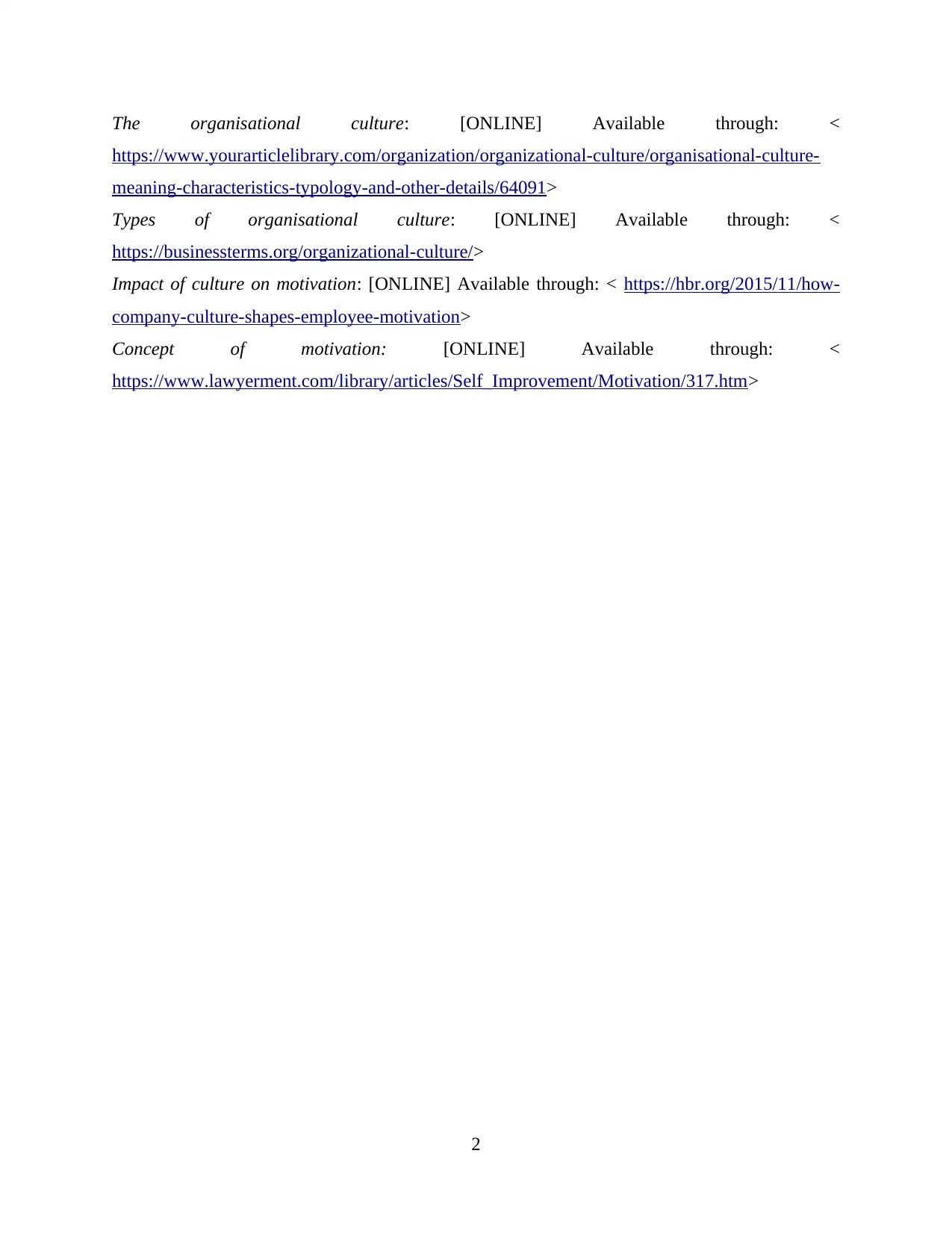
The organisational culture: [ONLINE] Available through: <
https://www.yourarticlelibrary.com/organization/organizational-culture/organisational-culture-
meaning-characteristics-typology-and-other-details/64091>
Types of organisational culture: [ONLINE] Available through: <
https://businessterms.org/organizational-culture/>
Impact of culture on motivation: [ONLINE] Available through: < https://hbr.org/2015/11/how-
company-culture-shapes-employee-motivation>
Concept of motivation: [ONLINE] Available through: <
https://www.lawyerment.com/library/articles/Self_Improvement/Motivation/317.htm>
2
https://www.yourarticlelibrary.com/organization/organizational-culture/organisational-culture-
meaning-characteristics-typology-and-other-details/64091>
Types of organisational culture: [ONLINE] Available through: <
https://businessterms.org/organizational-culture/>
Impact of culture on motivation: [ONLINE] Available through: < https://hbr.org/2015/11/how-
company-culture-shapes-employee-motivation>
Concept of motivation: [ONLINE] Available through: <
https://www.lawyerment.com/library/articles/Self_Improvement/Motivation/317.htm>
2
⊘ This is a preview!⊘
Do you want full access?
Subscribe today to unlock all pages.

Trusted by 1+ million students worldwide
1 out of 12
Related Documents
Your All-in-One AI-Powered Toolkit for Academic Success.
+13062052269
info@desklib.com
Available 24*7 on WhatsApp / Email
![[object Object]](/_next/static/media/star-bottom.7253800d.svg)
Unlock your academic potential
Copyright © 2020–2025 A2Z Services. All Rights Reserved. Developed and managed by ZUCOL.





